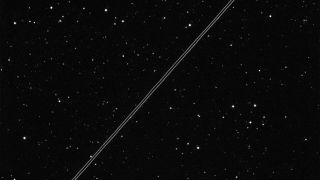China’s recently launched “Thousand Sails” satellites are so bright they can clearly be seen with the naked eye at night, far exceeding the limits proposed by astronomical authorities, experts say.
Many more of the mysterious satellites will be launched over the next few years — some of which could be even brighter than the ones we can already see — potentially causing major headaches for scientists and space enthusiasts.
Qianfan, meaning Thousand Sails, is a proposed “megaconstellation” of communication satellites being manufactured by the state-owned company Shanghai Spacecom Satellite Technology (SSST). The planned network is China’s answer to SpaceX’s Starlink satellites, which are designed to deliver high-speed internet across the globe. Very little is known about the project or the design of these new spacecraft, but Chinese state media previously revealed that the country aims to put up to 15,000 of the satellites in space by 2030, according to Reuters.
The first batch of Qianfan satellites were launched Aug. 6 on board a Long March 6A rocket that lifted off from the Taiyuan Satellite Launch Center in northern China, Live Science’s sister site Space.com reported at the time. The mission successfully deployed 18 satellites into a low-Earth orbit (LEO). However, the rocket’s second stage subsequently broke apart, littering LEO with more than 300 pieces of potentially hazardous space junk.
Related: Chinese scientists call for plan to destroy Elon Musk’s Starlink satellites
In a new paper, uploaded Sept. 27 to the preprint server arXiv, astronomers analyzed the first ground-based observations of the recently deployed satellites. These initial sightings revealed that the satellites are much brighter than expected. (The study’s findings have not yet been peer-reviewed.)
The profile of the light signatures given off by the satellites also confirms what little information we had about the satellites design, the researchers noted. They appear to have a flat antenna panel facing toward the Earth and a perpendicular solar array pointing away from our planet, similar to Starlink satellites, researchers wrote.
At their peak brightness, when the satellites are positioned directly above the observer, the spacecraft can reach an apparent magnitude of 4 — around the same as most stars visible at night from urban areas — while the brightness drops off to an apparent magnitude of 8 (40 times fainter than magnitude 4) when the satellites are closer to the horizon. (Apparent magnitude is measured on a logarithmic scale where smaller values are attributed to brighter objects.)
The International Astronomical Union’s Centre for the Protection of Dark and Quiet Skies from Satellite Constellation Interference (CPS) recommends that commercial satellites stay above an apparent magnitude of 7, which is too faint to see with the naked eye, SpaceNews.com reported. This prevents the satellites from photobombing images of the night sky and interfering with astronomical research. However, CPS has no power to enforce this brightness limit.
The scientists warn that some Qianfan satellites are scheduled to be deployed at even lower altitudes in LEO, meaning they could end up being 1 to 2 magnitudes brighter than those observed in the new study. Once the megaconstellation begins to take shape, it “will adversely impact professional and amateur astronomical activities unless the operators mitigate their brightness,” the researchers wrote in the paper.

Similar concerns have previously been raised about Starlink satellites, as well as the world’s largest communication satellite, BlueWalker 3, which astronomers have dubbed a “photobombing menace.”
The study researchers noted that it is possible to reduce the amount of light reflected off communication satellites using built-in mirrors, as SpaceX has done with its second-generation Starlink satellites that began launching last year. The researchers have urged SSST to do the same.
However, CPS has previously noted that their contact with China “has been limited,” suggesting that it may be harder to coerce them into modifying their satellites, according to SpaceNews.com.
In addition to polluting the night sky with light, communication satellites can also disrupt radio astronomy by leaking radiation into space, which is still an issue with the newest generation of Starlink satellites. However, more observations are needed to determine if Qianfan satellites have the same problem.
Satellite magaconstellations have also been criticized for increasing the likelihood of spacecraft collisions in LEO, generating space junk, being knocked out of orbit by solar storms and littering the upper atmosphere with metal pollution when they burn up upon reentry.


